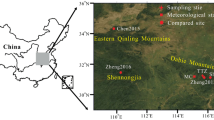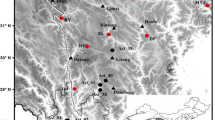Abstract
The overlap region between the eastern fringe of the Asian westerly region and the temperate continental-monsoon climate transition zone is sensitive to climate changes and is characterized by fragile ecosystems. Uncovering the long-term historical climate variability patterns in this region is necessary. A standardized tree-ring width chronology was constructed based on the tree-ring samples collected from four representative tree species in four typical areas in the overlap region, and the 203- to 343-year annual mean minimum temperature series in the overlap region were reconstructed. The reconstructed series overlapped well with extreme climate events and low-temperature periods recorded in historical data. Therefore, the reconstructed model is stable and reliable. As suggested by the reconstructed series, the annual average minimum temperature in the overlap region changes sharply from east to west, and the periodicity change in the overlap region shows a trend of gradually weakening from the east and west ends to the middle. In the nineteenth century, the high-latitude area was in the high-temperature period, and the entire overlap region experienced significant low-temperature periods lasting 20–45 years until the 1950s. The western part had an earlier low-temperature period start time, a longer cooling duration, and a slower cooling rate than the central part. The overlap region experienced a significant warming period in approximately the last half-century, with temperatures increasing faster in the western and eastern parts than in the central part. The temperature variability in the overlap region was more intense in the last two centuries, with shorter periodicities and a larger proportion of cold periods. The central and western parts of the Asian westerly region, the mid- to high-latitude regions of the transition zone, and the overlap region experienced significant low-temperature periods or drastic cooling trends (the Little Ice Age) in the first half of the nineteenth century and significant warming trends afterwards due to global warming. The influences of these changes may have been exacerbated by the westerly circulation. The results of this study provide new insights into the use of dendroclimatology to extract temperature series in the Asian westerly region and the transition zone and a reference for research on global climate change.








Similar content being viewed by others
References
Akkemik Ü, D’Arrigo R, Cherubini P, Köse N, Jacoby GC (2008) Tree-ring reconstructions of precipitation and streamflow for north-western Turkey. Int J Climatol: A J Royal Meteorol Soc 28(2):173–183
Cai Q, Liu Y, Fang C, Xie M, Zhang H, Li Q, Song H, Sun C, Liu R, Di T (2022) Insight into spatial-temporal patterns of hydroclimate change on the Chinese Loess Plateau over the past 250 years, using new evidence from tree rings. Sci Total Environ:157960
Cook ER, Jacoby GC (1983) Potomac River streamflow since 1730 as reconstructed by tree rings. J Appl Meteorol Climatol 22(10):1659–1672
Cook ER, Anchukaitis KJ, Buckley BM, D’Arrigo RD, Jacoby GC, Wright WE (2010) Asian monsoon failure and megadrought during the last millennium. Science 328(5977):486–489
Cook ER (1985) A time series analysis approach to tree ring standardization. University of Arizona Tucson
D’Arrigo R, Wilson R, Deser C, Wiles G, Cook E, Villalba R, Tudhope A, Cole J, Linsley B (2005) Tropical-North Pacific climate linkages over the past four centuries. J Clim 18(24):5253–5265
Earle C, Brubaker L, Lozhkin A, Anderson P (1994) Summer temperature since 1600 for the upper Kolyma region, northeastern Russia, reconstructed from tree rings. Arct Alp Res 26(1):60–65
Feng S, Hu Q, Huang W, Ho C-H, Li R, Tang Z (2014) Projected climate regime shift under future global warming from multi-model, multi-scenario CMIP5 simulations. Global Planet Change 112:41–52
Fritts, H (1976) Tree rings and climate, Academic Press Inc. (London) Ltd., London.
Fritts H (1991) Reconstruction large scale climate patterns from tree-ring data, Tuson, USA. Arizona− The Arizona University Press
Fu C (1992) The definition and detection of the abrupt climatic change. Sci Atmos Sin 16:482–493
Gao Z, Chen F, Fang K (2021) Runoff reconstruction for the Bailong River from tree rings back to AD 1601, reveals changing hydrological signals of China north–south transition zone. Hydrol Processes 35(11):e14417
Gutiérrez Merino E (1989) Dendroclimatological study of Pinus sylvestris L. in southern Catalonia (Spain). Tree-Ring Bulletin, 1989, vol 49, p1–9
Holmes R (1983) Computer Assisted Quality Control Tree-Ring Bull 43:69–78
IPCC (2014) Climate Change. “Mitigation of climate change”: contribution of working group III to the fifth assessment report of the intergovernmental panel on climate change
Jiang Y, Liu C, Zhang J, Han S, Coombs CE, Wang X, Wang J, Hao L, Dong S (2021) Tree ring width-based January–March mean minimum temperature reconstruction from Larix gmelinii in the Greater Khingan Mountains, China since AD 1765. Int J Climatol 41:E842–E854
Kamenos NA, Hoey TB, Nienow P, Fallick AE, Claverie T (2012) Reconstructing Greenland ice sheet runoff using coralline algae. Geology 40(12):1095–1098
Kirchhefer AJ (2000) Dendroclimatology on Scots pine (Pinus sylvestris L.) in northern Norway
Li J, Yuan Y, You X (2000) Research and application of dendrohydrology. Science Press, Beijing
Li, S. (1998). Records of Ejin Banner. Local records Publishing House.
Li, J. (2010). Study on the historical evolution of ecological environment in Heihe River Basin. Doctoral dissertation, Zhejiang Normal University.
Liang L, Ma L, Liu T, Sun B, Zhou Y (2018) Spatiotemporal variation of the temperature mutation and warming hiatus over northern China during 1951–2014. China Environ Sci 38(5):1601–1615
Liu Y, Sun J, Song H, Cai Q, Bao G, Li X (2010) Tree-ring hydrologic reconstructions for the Heihe River watershed, western China since AD 1430. Water Res 44(9):2781–2792
Liu Y, Zhang X, Song H, Cai Q, Li Q, Zhao B, Liu H, Mei R (2017) Tree-ring-width-based PDSI reconstruction for central Inner Mongolia, China over the past 333 years. Clim Dyn 48(3):867–879
Mann ME, Bradley RS, Hughes MK (1998) Global-scale temperature patterns and climate forcing over the past six centuries. Nature 392(6678):779–787
Mann ME, Bradley RS, Hughes MK (1999) Northern hemisphere temperatures during the past millennium: inferences, uncertainties, and limitations. Geophys Res Lett 26(6):759–762
Peng Z, Qin L, Li X, Zhang H, Chen Y, Liu R, Zhang R (2020) Tree-ring-based temperature reconstruction since 1766 CE in the eastern Tianshan Mountains, arid Central Asia. Theor Appl Climatol 142(1):687–699
Rossby C-G (1939) Relation between variations in the intensity of the zonal circulation of the atmosphere and the displacements of the semi-permanent centers of action. J Mar Res 2:38–55
Shang J, Shi Z, Gao J, Xu L, Lv S, Feng C, Wang L (2012) Response of tree-ring width of Pinus sylvestris var. mongolica to climate change in Hulunbuir sand land. China Acta Ecol Sin 32:1077–1084
Shen J (2008) The compilation of China meteorological disaster Canon. 2008 China meteorological disaster Canon. China Meteorological Press, China
Sun B, Ma L, Feng Q, Liu T, Liang L, Li H, Zhou Y, Liu Y (2019) Response of the warming hiatus to changing influences over the Inner Mongolia autonomous region. China Environ Sci 39:2131–2142
Tkachuck R (1983) The little Ice Age. Origins 10(2):51–65
Venugopal V, Foufoula-Georgiou E (1996) Energy decomposition of rainfall in the time-frequency-scale domain using wavelet packets. J Hydrol 187(1–2):3–27
Wada Y, Bierkens MF (2014) Sustainability of global water use: past reconstruction and future projections. Environ Res Lett 9(10):104003
Wen K (2008) The compilation of China meteorological disaster Canon. China Meteorological Press, Beijing (in Chinese)
Yu D, Wang Q, Wang Y, Zhou W, Ding H, Fang X, Jiang S, Dai L (2011) Climatic effects on radial growth of major tree species on Changbai Mountain. Ann for Sci 68(5):921–933
Zhang R, Yuan Y, Yu S, Chen F, Zhang T (2017a) Past changes of spring drought in the inner Tianshan Mountains, China, as recorded by tree rings. Boreas 46(4):688–696
Zhang X, Liu Y, Song H, Cai Q, Li Q, Zhao B, Liu H, Mei R (2017b) Interannual variability of PDSI from tree-ring widths for the past 278 years in Baotou. China Trees 31(5):1531–1541
Zhang R, Qin L, Shang H, Yu S, Gou X, Mambetov BT, Bolatov K, Zheng W, Ainur U, Bolatova A (2020a) Climatic change in southern Kazakhstan since 1850 CE inferred from tree rings. Int J Biometeorol 64(5):841–851
Zhang, R., Qin, L., Shang, H., Yu, S., Gou, X., Mambetov, B. T., Bolatov, K., Zheng W. J., Ainur, U & Bolatova, A. (2020b). Climatic change in southern Kazakhstan since 1850 CE inferred from tree rings. International Journal of Biometeorology, 1–11.
Acknowledgements
This research was supported by the Natural Science Foundation of China (Grant Nos. 52069019 and 51669016). We are grateful for their support.
Author information
Authors and Affiliations
Contributions
Bolin Sun carried out the analysis and compiled the proxy datasets. Tingxi Liu helped in the experimental design. Xing Huang provided the climate model data. Bolin Sun and Long Ma provided guidance in the interpretation and compilation of proxy data. Bolin Sun wrote the paper, with contributions from all authors.
Corresponding author
Ethics declarations
Competing interests
The authors declare no competing interests.
Additional information
Publisher’s note
Springer Nature remains neutral with regard to jurisdictional claims in published maps and institutional affiliations.
Rights and permissions
Springer Nature or its licensor (e.g. a society or other partner) holds exclusive rights to this article under a publishing agreement with the author(s) or other rightsholder(s); author self-archiving of the accepted manuscript version of this article is solely governed by the terms of such publishing agreement and applicable law.
About this article
Cite this article
Sun, B., Ma, L., Liu, T. et al. Variability in the minimum temperature over two centuries in the overlap region between the fringe of the Asian westerly region and the temperate continental-monsoon climate transition zone. Int J Biometeorol 67, 181–194 (2023). https://doi.org/10.1007/s00484-022-02397-w
Received:
Revised:
Accepted:
Published:
Issue Date:
DOI: https://doi.org/10.1007/s00484-022-02397-w




